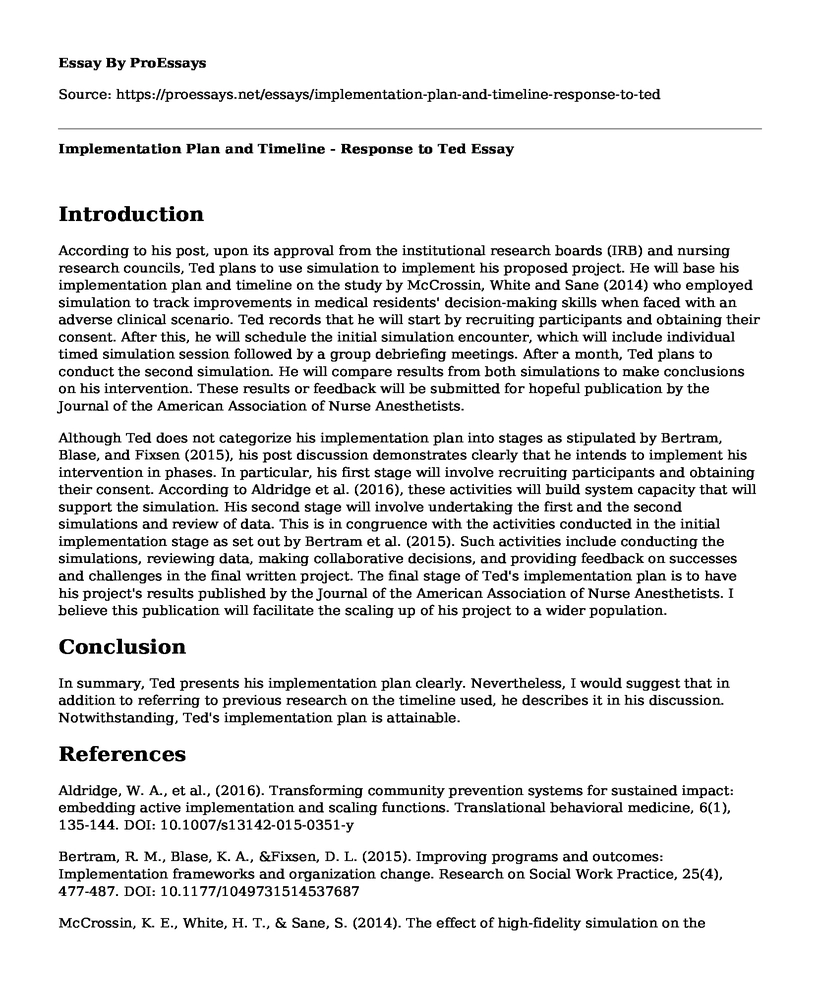Introduction
According to his post, upon its approval from the institutional research boards (IRB) and nursing research councils, Ted plans to use simulation to implement his proposed project. He will base his implementation plan and timeline on the study by McCrossin, White and Sane (2014) who employed simulation to track improvements in medical residents' decision-making skills when faced with an adverse clinical scenario. Ted records that he will start by recruiting participants and obtaining their consent. After this, he will schedule the initial simulation encounter, which will include individual timed simulation session followed by a group debriefing meetings. After a month, Ted plans to conduct the second simulation. He will compare results from both simulations to make conclusions on his intervention. These results or feedback will be submitted for hopeful publication by the Journal of the American Association of Nurse Anesthetists.
Although Ted does not categorize his implementation plan into stages as stipulated by Bertram, Blase, and Fixsen (2015), his post discussion demonstrates clearly that he intends to implement his intervention in phases. In particular, his first stage will involve recruiting participants and obtaining their consent. According to Aldridge et al. (2016), these activities will build system capacity that will support the simulation. His second stage will involve undertaking the first and the second simulations and review of data. This is in congruence with the activities conducted in the initial implementation stage as set out by Bertram et al. (2015). Such activities include conducting the simulations, reviewing data, making collaborative decisions, and providing feedback on successes and challenges in the final written project. The final stage of Ted's implementation plan is to have his project's results published by the Journal of the American Association of Nurse Anesthetists. I believe this publication will facilitate the scaling up of his project to a wider population.
Conclusion
In summary, Ted presents his implementation plan clearly. Nevertheless, I would suggest that in addition to referring to previous research on the timeline used, he describes it in his discussion. Notwithstanding, Ted's implementation plan is attainable.
References
Aldridge, W. A., et al., (2016). Transforming community prevention systems for sustained impact: embedding active implementation and scaling functions. Translational behavioral medicine, 6(1), 135-144. DOI: 10.1007/s13142-015-0351-y
Bertram, R. M., Blase, K. A., &Fixsen, D. L. (2015). Improving programs and outcomes: Implementation frameworks and organization change. Research on Social Work Practice, 25(4), 477-487. DOI: 10.1177/1049731514537687
McCrossin, K. E., White, H. T., & Sane, S. (2014). The effect of high-fidelity simulation on the confidence and decision-making ability of anaesthesia trainees in managing subsequent simulated 'can't intubate, can't oxygenate' scenarios. Anaesthesia and Intensive Care, 42(2), 207-12. Retrieved from https://ezproxy.wilkes.edu/login?url=https://search-proquest-com.ezproxy.wilkes.edu/docview/1507224010?accountid=62703
Cite this page
Implementation Plan and Timeline - Response to Ted. (2022, Dec 05). Retrieved from https://proessays.net/essays/implementation-plan-and-timeline-response-to-ted
If you are the original author of this essay and no longer wish to have it published on the ProEssays website, please click below to request its removal:
- Nurses' Knowledge and Attitudes About Pain Essay
- Essay Sample on Managing Sleep Disorder in the Elderly
- Teen Pregnancy Prevention Policy - Essay Sample
- Research Proposal on Teen Mothers' Social & Economic Experiences in Low-Income Areas
- Nurses' Empowerment: Motivating & Demotivating Factors in the Workplace - Essay Sample
- Essay Example on US Flu Surveillance Data Unreliable: Estimates Used Instead of Cases
- Essay Example on Infographics: A Key Tool for Nurses in Handling Patients & Diagnosis







